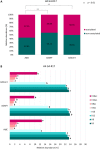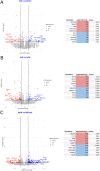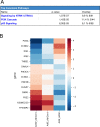Epigenetic and transcriptional control of adipocyte function by centenarian-associated SIRT6 N308K/A313S mutant
- PMID: 39033117
- PMCID: PMC11265064
- DOI: 10.1186/s13148-024-01710-1
Epigenetic and transcriptional control of adipocyte function by centenarian-associated SIRT6 N308K/A313S mutant
Abstract
Background: Obesity is a major health burden. Preadipocytes proliferate and differentiate in mature adipocytes in the adipogenic process, which could be a potential therapeutic approach for obesity. Deficiency of SIRT6, a stress-responsive protein deacetylase and mono-ADP ribosyltransferase enzyme, blocks adipogenesis. Mutants of SIRT6 (N308K/A313S) were recently linked to the in the long lifespan Ashkenazi Jews. In this study, we aimed to clarify how these new centenarian-associated SIRT6 genetic variants affect adipogenesis at the transcriptional and epigenetic level.
Methods: We analyzed the role of SIRT6 wild-type (WT) or SIRT6 centenarian-associated mutant (N308K/A313S) overexpression in adipogenesis, by creating stably transduced preadipocyte cell lines using lentivirus on the 3T3-L1 model. Histone post-translational modifications (PTM: acetylation, methylation) and transcriptomic changes were analyzed by mass spectrometry (LC-MS/MS) and RNA-Seq, respectively, in 3T3-L1 adipocytes. In addition, the adipogenic process and related signaling pathways were investigated by bioinformatics and biochemical approaches.
Results: Overexpression of centenarian-associated SIRT6 mutant increased adipogenic differentiation to a similar extent compared to the WT form. However, it triggered distinct histone PTM profiles in mature adipocytes, with significantly higher acetylation levels, and activated divergent transcriptional programs, including those dependent on signaling related to the sympathetic innervation and to PI3K pathway. 3T3-L1 mature adipocytes overexpressing SIRT6 N308K/A313S displayed increased insulin sensitivity in a neuropeptide Y (NPY)-dependent manner.
Conclusions: SIRT6 N308K/A313S overexpression in mature adipocytes ameliorated glucose sensitivity and impacted sympathetic innervation signaling. These findings highlight the importance of targeting SIRT6 enzymatic activities to regulate the co-morbidities associated with obesity.
Keywords: Adipogenesis; Epigenetics; Histones; Obesity; SIRT6.
© 2024. The Author(s).
Conflict of interest statement
The authors declare no competing interests.
Figures








References
-
- https://www.who.int/news-room/fact-sheets/detail/obesity-and-overweight, A.f. World Health Organization. Obesity and overweight. WHO Newsroom Fact Sheets. 2022.
MeSH terms
Substances
Grants and funding
LinkOut - more resources
Full Text Sources
Other Literature Sources
Molecular Biology Databases
Miscellaneous

